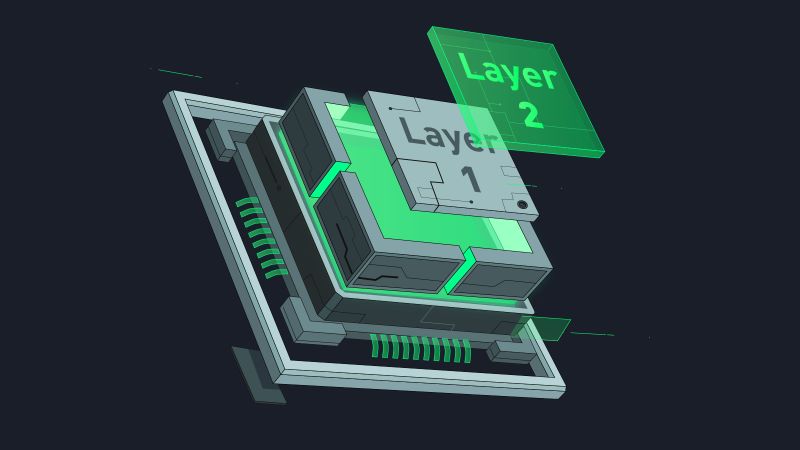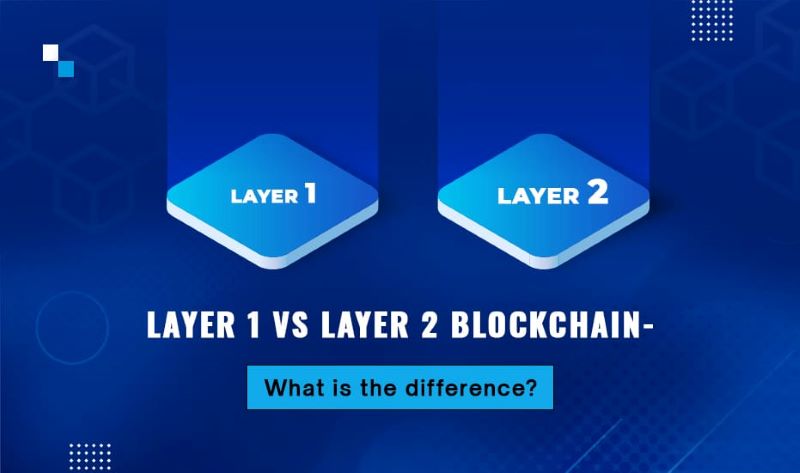In the world of digital ledgers, a silent clash is brewing: blockchain layer 1 vs layer 2. As an expert, I’ve seen the buzz these two terms generate. Layer 1 is the ground floor, the main framework of blockchain tech where everything began. Layer 2 jumps in as the spry newcomer, building on top of this to make transactions faster and cheaper. Both are pivotal in the crypto universe, but they serve different needs. It’s time we cut through the confusion and get to the heart of what sets them apart. We’ll explore the backbone that holds our digital currencies together and then dive into the innovations layered on to send them soaring. Get ready to decipher this crucial piece of the crypto puzzle and understand why every byte and block matters.
Understanding the Basics of Blockchain Foundations
Delving into Basic Blockchain Technology
Let’s dig into what holds up every blockchain: the base layer. Think of it as the ground floor in a huge building. Blockchain foundations are like concrete, steel, or sturdy wood. They must be strong so they can hold up everything built on top. This is where the basic blockchain technology comes in.
The base layer blockchain, or layer 1, is the core. It’s the engine of a car or the heart in our chest. This first layer is where all the blockchain action starts. It records every trade, sale, or swap. Whenever you hear about Bitcoin or Ethereum, you think of layer 1 networks.
The Role and Function of Base Layer Blockchain
So, what is layer 1 blockchain doing for us? It does a lot. It lets people across the world trade and share without a middleman. It keeps records safe and sound so you can trust them. Layer 1 protocols set the rules for how each trade or share is done.
We say Bitcoin or Ethereum are layer 1 blockchain examples. These systems are like big community ledgers or lists, open for all to see. Everyone agrees because the list is the same for everyone. It’s the primary blockchain infrastructure that holds our trust in this digital world.
Layer 1 solutions keep our digital stuff safe. They make sure no one tricks us or messes up our trades. But there’s a catch – too many people using it can slow things down. This is when the blockchain scalability issues pop up. We need it fast and simple, yet solid and secure, right?
That’s where the second floor, or layer 2 blockchain, enters the story. Layer 2 scaling solutions are like adding express elevators to our building. They speed things up without changing our solid foundation. Layer 2 protocols include sidechains, state channels, off-chain solutions, and even nested blockchain layers.
Think of layer 1 as the main roads in your town and layer 2 as shortcuts. The main roads never change. They are stable and trustworthy. But if everyone used them at the same time, we’d be stuck in traffic. So, we make new paths that tie back to the main roads. This is what layer 2 enhancements do for blockchain.
Layer 1 handles the basics, the must-dos, like keeping records and setting rules. It’s our trusty home base for all things blockchain. Got it? Good. Now we’re ready to dive into the fast, clever world of layer 2 – but that’s a tale for another part of our journey.
In our quest for a quicker, smoother blockchain, remember the base layer’s essential role. It’s the sturdy ground on which digital trust is built. Understanding blockchain layers is key to seeing the full picture of how our digital value moves.
Let’s keep exploring. We’ll uncover how this tech is evolving, and see how layer 1 and layer 2 tackle big questions like speed, safety, and working together. Stay tuned!
Dissecting Layer 1: The Backbone of Blockchain
Exploring Layer 1 Blockchain Examples and Networks
What is layer 1 blockchain? It’s the base layer, where all the action happens. It’s like the ground floor of a building, carrying all that’s built on it. Bitcoin and Ethereum are examples of layer 1 networks. They started the whole blockchain boom. Their main job is to keep the network secure and run according to rules called consensus mechanisms.
Layer 1 blockchain examples work like this. Take Bitcoin. People use it to send money all over the world. But it’s not just money moving. It’s trust, not needing anyone to check things. It’s pretty clever how it works – by many computers solving puzzles. Same goes for other layer 1 networks. They have their own rules but aim for the same thing – a safe way to agree on what’s true, without any one boss.
Layer 1 solutions include how to handle more users and bigger loads. Think of it like a busy road. Too many cars cause traffic jams. So the aim is to find ways for more cars without the jams. And that’s just what layer 1 is trying to do. It’s not easy, but super important for everyone using the network.
The Evolution and Impact of Layer 1 Solutions and Protocols
Now let’s talk about why layer 1 matters so much. When we started using blockchain, we saw it was slow with too many people. Not so fun if you’re stuck waiting. We needed to make it faster while keeping it strong. So, the smart folks in blockchain came up with some neat tricks.
They created new layer 1 protocols. These are fresh rules on how to run things. They help manage more people and actions on the network. Some make blocks bigger, so they hold more stuff. Others speed up how fast blocks are made. These changes help a lot. But it’s like a balancing act. Making things faster can lead to less trust. So, we keep tweaking to find the best mix.
Layer 1 networks are super busy these days. They have to carry all the apps and deals we do. It gets crowded, just like a popular game everyone wants to play. To keep everyone happy, layer 1 got to work better. It means finding ways to let everyone play without wait times and errors.
People who make apps need this. They want to build cool stuff for users. But if the layer 1 is slow, no one’s happy. That’s why we need strong and smart layer 1 solutions. They are the base that holds everything up. All the cool things we want to do in crypto land, they start with layer 1. So it’s got to be just right. We need it safe, fast, and able to handle loads of action.
That’s the story of layer 1 – the backbone of blockchain. We’ve come far, but there’s more road ahead. As we pile on more stuff – smart contracts, dApps – layer 1’s got to keep up. It’s a big job, but one thing’s for sure. Layer 1 will keep evolving, getting even better at handling our crypto world. And that’s something to get excited about!
The Advent of Layer 2: Scaling and Enhancing Blockchain
Examining Layer 2 Scaling Solutions and Protocols
Let’s dive into the world of layer 2. What is layer 2 blockchain? Layer 2 is tech that sits atop the base layer. It offers extra features like faster transactions without clogging the main blockchain. Think of layer 1 as the main highway and layer 2 as special express lanes. They don’t replace the highway, but help manage more cars at speed.
So, what are layer 2 scaling solutions? These are the tricks we use to zoom past blockchain traffic jams. You’ve heard about blockchains being slow and costly, right? Well, layer 2 scaling pulls some data off the main road, so we keep moving. It’s like taking a few cars off the road to clear up traffic.
Layer 2 protocols are the rules or methods for these solutions. Protocols like state channels let two people do many fast deals together, only using the main blockchain to enter or leave the channel. Sidechains are separate lanes that let you do your thing on the side, only touching the main blockchain now and then.
Imagine you’re at a theme park. Instead of everyone waiting in one big line, layer 2 puts up several smaller rides. You get on quicker, and you can ride more often.
The Significance of Off-Chain Solutions and Layer 2 Enhancements
Now, let’s talk about off-chain solutions. These take stuff off the main blockchain to do them away from the crowd. Why does it matter? These cuts down on the wait time massively. Speed is key in blockchain, and layer 2 makes things zip along.
How do layer 2 enhancements help? They make sure we can all use blockchain, even when it gets super busy. Just like adding more checkout lines at a store during holidays, layer 2 enhancements keep the lines moving, so no one’s waiting too long.
Layer 2 isn’t just about speed, though. It’s also about fitting more people and deals onto the blockchain. It’s like a magic backpack that never gets full. You can keep putting stuff in. This mass add-on is a huge deal for blockchain foundations.
When we talk consensus mechanisms layer 1 and 2, we’re chatting about how decisions are made. Layer 1 may have a whole group voting, but layer 2 can let smaller squads make choices fast. Both are safe, just done in different ways.
For smart contracts and dApps, layer 2 is like a turbo boost. They can run quicker and cost less than on layer 1. So, developers creating apps find this super handy.
Understanding layer 2 gets you how basic blockchain technology is leveling up. It’s solving big headaches like wait times and costs. For everyone using blockchain, this means we can do more, worry less, and keep on making cool stuff for the future.
The Layer 1 vs. Layer 2 Showdown: Scalability, Security, and Interoperability
Comparing Throughput, Decentralization, and Security Aspects
Let’s cut to the chase: layer 1 is the base. It’s like the roots of a tree. Layer 1 blockchains are the big names like Bitcoin and Ethereum. They started it all. Now, think of layer 2 as a strong branch. It grows from layer 1 and helps it do more. Blockchain can be slow when too many people use it. Layer 1 can get crowded. This is where layer 2 comes in.
Layer 2 makes everything faster. It takes some work off layer 1’s back. It handles transactions away from the main chain. Then, it records them on layer 1 together. Think of it like a bus. Instead of many cars on a road, a bus takes many people at once. This is how layer 2 boosts speed.
Now, we all love to share. But in blockchain, we call it being decentralized. It means no one’s the boss. Everyone’s in charge together. Layer 1 is great at this. But when layer 2 steps in, it’s tricky. We need to keep it just as fair and open. That’s where the smart folks come in. They’re always thinking up new ways to keep it decentralized.
What about keeping everything safe? We need strong walls in our digital castle. Both layer 1 and layer 2 must be Fort Knox for your digital gold. When set up right, layer 2 can be just as safe as layer 1. It’s a team effort.
The Future of dApps: Interaction Between On-Chain and Off-Chain Solutions
We dream big in the world of dApps, decentralized apps. They are destined to change the game. I’m talking about apps that run on blockchains. We use layer 1 for truth and trust. Its main job is to keep records safe and sound. But with dApps getting popular, layer 1 can get crowded.
Enter layer 2, the ace up our sleeve. It helps dApps work better. It deals with the nitty-gritty, so layer 1 doesn’t have to. Off-chain solutions like sidechains, state channels, heck even nested layers, they’re the special tools. They take the heavy lifting off layer 1.
It’s like a busy kitchen in a restaurant. Layer 1 is the head chef, keeping an eye on everything. Layer 2 are the sous-chefs. They prep and cook so the head chef can focus on the big picture. Together, they make a meal faster and tastier. That’s how on-chain and off-chain work together. It’s about being smart with our resources.
This teamwork helps dApps scale up. With layer 2, a dApp can serve not just a few hundred, but millions. And as this happens, we’ll see more cool apps. They will pop up in finance, games, and even social media.
The future is bright, friends. Layer 1 and layer 2 have their roles. But together, they’re building a faster, safer, and more open world for us all. It’s an exciting time to be a part of it. Blockchain is growing and adapting. As it does, layer 1 keeps it strong at the core, and layer 2 builds out its potential.
We’ve dug deep into blockchain’s layers, from basics to the layer 1 and 2 details. We explored how layer 1 forms the core and how layer 2 builds on it to make things faster and better. These layers work together to keep blockchain strong and ready for the future. Think of layer 1 as the roots and layer 2 as the branches that reach out for more. As tech grows, so does blockchain. It’s a team effort. Each layer has a role that helps our digital world run smooth. Keep your eyes on how they mix – it’s going to be big for apps and the web. Trust me, I’ve seen the ins and outs, and I’m telling you, blockchain’s layers are game changers.
Q&A :
What is the difference between Layer 1 and Layer 2 blockchain?
Layer 1 refers to the base protocol or the underlying main blockchain architecture, such as Bitcoin or Ethereum. It encompasses the entire system and manages the consensus algorithm and network security. Conversely, Layer 2 is an overlaying network that sits on top of the Layer 1 blockchain to provide scalability and faster transaction speeds by handling transactions off the main chain.
How does Layer 2 improve blockchain scalability?
Layer 2 solutions help in scaling blockchain by taking transaction processing off-chain, which reduces the burden on the Layer 1 blockchain. Techniques such as state channels, sidechains, and rollups are employed, which allow for numerous transactions to be processed in a second without bogging down the main chain. This ultimately leads to higher throughput and lower transaction fees.
Can Layer 1 and Layer 2 solutions work together harmoniously?
Yes, Layer 1 and Layer 2 solutions are designed to work in concert. Layer 1 provides the foundational security and decentralization, while Layer 2 enhances scalability and transaction speed. When integrated effectively, they create a synergistic effect that improves overall network efficiency and user experience.
Why are Layer 2 solutions necessary for blockchain networks?
As blockchain networks have grown in popularity, the limitations of Layer 1 blockchains, particularly in terms of scalability and transaction cost, have become apparent. Layer 2 solutions are necessary to overcome these challenges and ensure that blockchain networks can accommodate growing demand, increased transaction volume, and strive to deliver real-time performance.
What are some examples of Layer 2 solutions in blockchain?
There are various Layer 2 scaling solutions implemented across different blockchains. Notable examples include the Lightning Network for Bitcoin, which enables fast and efficient micropayments, and the Plasma, Arbitrum, and Optimism solutions for Ethereum, each providing different mechanisms for executing smart contracts and processing transactions at a faster rate than the Ethereum mainnet (Layer 1).


